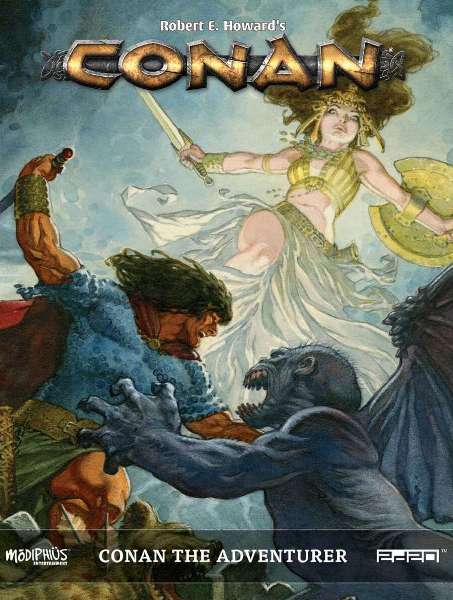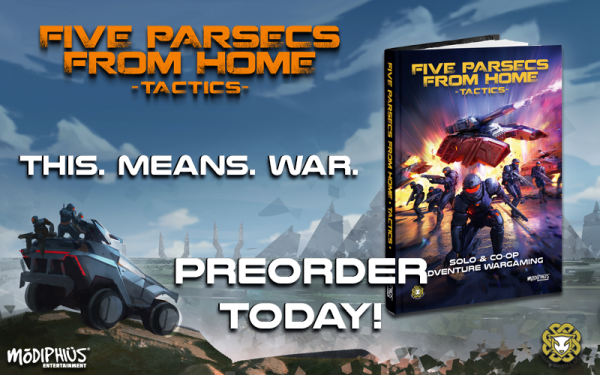
Conan the Adventurer
Conan the Adventurer is a supplement for the pulp fantasy Robert E. Howard’s Conan, written by Vincent Darlage, Mark Carroll, Chris Harris, Chris Lites, and Jason Durall and published by Modiphius Entertainment
By Stephen Reuille

Learn more about Conan the Adventurer here
Purchase Conan the Adventurer here (paid link)
Find other Conan posts here
When I was in my teens, I read the stories of Robert E. Howard. I was fascinated by the adventures of his characters with my favorite being Conan. His journeys spurred my imagination and helped create a lifelong roleplayer. When Modiphius came out with the Conan RPG, I was excited. I ran the Jumpstart adventure at my FLGS to promote their endeavor. I now have the privilege to review my third Conan RPG release, that being Conan the Adventurer sourcebook. The copy of the product I am reviewing is a PDF. Since my background is not in PDFs however, I will not be commenting on some of the items a more tech savvy reviewer might. My review will be of the content and not the add-ons a PDF purchaser may use to increase the document’s utility. Now with my disclaimer out of the way, let’s journey down to the Southern Kingdoms.
Conan the Adventurer weights in at 111 pages with an index at the end just like Conan the Scout & Conan the Exiles. The book is broken down into seven chapters. The introduction is pretty standard fare with a paragraph or two about each chapter.
After the quick introduction, we start with Chapter One containing new character creation information like the other two sourcebooks. Anyone who has read my earlier reviews knows this is my least favorite part. Usually I find there is little adding to the game for the player, however this book is different. Two of the Archetypes, Witch Finder and Griot, are interesting and fit the book’s setting well. Griot even has new rules unlike the previous books. The Griot in particular added many new Talents. For those that do not know, a Griot is like a bard. Their Talents help the character buff the group and act as spell-like effects. The chapter has the Castes Laborer, Scribes, and expands Priests. There are also Southern Castes like Axumite, Clever Ones (with knowledge of deities and spirits), and Tribesperson with many Stories and Educations to add flavor. Most of the Stories and Educations can fit Conan characters from any region. They are also quite evocative of a sword and sorcery game with my favorites being Spoke with the Dead, Dreams of Set, and Wisdom of the Stars. I want to play a character with the last one. The chapter continues with a good listing of names for characters and how to think about names in the Southern Kingdoms as there are differences in naming conventions in the South. The chapter ends with the new gods of the South, their points of interest and a short list of gear.
Chapter Two describes the Southern and Black Kingdoms beyond the River Styx in detail. I must say the maps in this chapter are the best of the three Conan books I reviewed. So a big step in the right direction. But what about the text you say? I had a great time reading this section. It took me back to my younger days reading Conan stories for the first time. The exotic locations turned my imagination. They were not just a general travel log, like I thought of The Exiles. The chapter not only describes the larger kingdoms like Stygia and the various Black Kingdoms but minor kingdoms like the Amazon and the Black Coast get a couple paragraphs. The peoples of these lands get some description as well. The Darfari are given a good treatment about their culture, ways of war, and magical practices. The Keshani Horsemen and Gallahi, a people in opposition of Set, also get some description. The writing of this chapter is compelling but also packed with story ideas that could easily launch campaigns. Players could find their characters facing off against the Cult of Set, sneaking into the black castles of Khemi and the Red Tower, tomb robbing in the Necropolis or Akhan’s Tomb, leading slave revolts, fighting witches in the Miombo Woodlands, and so much more. I did not want to tell my whole list though.
In Chapter Three the book lists nine events. This is a short chapter with each of the events getting one to three paragraphs. If a Gamemaster did not get ideas in the previous chapter, these nine events are good campaign starters. These are just pocket ideas however; the Gamemaster will have to flesh them out.
Chapter Four is titled Myth and Magic. Because of the nature of the Southern Kingdoms, this chapter is a little more robust than previous sourcebooks. There is a good section on how the people of the South think about and interact with religion and magic on a personal and societal level. The chapter also includes ideas of animism, the gods of the Southern Kingdoms, the myths of the locals, sorcery, and a number of magical artifacts. A few pages of this chapter covers the Cult of Set and other cults. This gives just enough information for the Gamemaster to flavor them as adversaries but for a longer campaign, some more work will need done. With the Gazetteer chapter being so filled with ideas, I would have possibly cut Chapter Three and replaced it with a deeper dive into the Cult of Set and the other cults.
Speaking of adversaries, Chapter Five has statistics for many of the peoples and “other” to be encountered in the Southern Kingdoms. This chapter is robust as well. If this chapter is any indication, the South is an action filled region. In these pages there are details for giant animals, undead from vampires to mummies, cannibals, human headed snakes, demon lords, lions, tigers, and bears oh my! There are also over twenty named characters for the players to interact with from kings and queens to fellow adventurers. My favorites are the Riders of Ollam-Onga and the Lost Woman. However, let me know if you can get the buy-in from your players for the Lost Woman to be compelling.
The sixth chapter briefly describes Conan’s adventures in the South and gives stats for the man himself. A fun chapter if you want ideas on how to follow his trail and to use the legend in your games.
The last chapter is called Way of the South. Keeping the book in mind, this chapter sums up the differences in running games set in the Southern Kingdoms vs the rest of the lands Conan roams. It details cultural differences, rites of the South, conducting war and some Carousing rules. It also says in the South characters will encounter a larger number of nonhuman conflicts and if Chapter Five is any indication, I believe.
Before my conclusion I would like to mention the layout. The layout is the best of the three Conan sourcebooks I have reviewed. I loved the look of this book and the art was great. I usually state my favorite piece of art in my reviews and this time it was a tough decision. I am going to have to go with the cover art on this one but the pieces on pages 56 and 84 are a close second.
So is it worth the time and gold to travel to the Southern Kingdoms? I would say a resounding yes. Conan the Adventurer is full of useful information for both the players and Gamemaster. A player will find unique character options and a lot of advice on how to portray a person from the Southern Kingdoms. The Gamemaster will be given hours and hours of story ideas, campaign starters, and a great list of adversaries and foils. I could go on but a fan of the Conan RPG needs to just get this and see for yourself. If you don’t have the Conan RFG, why are you still reading this, then go get both books and start your adventures in the South. But be careful, you may not survive the trip.


